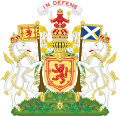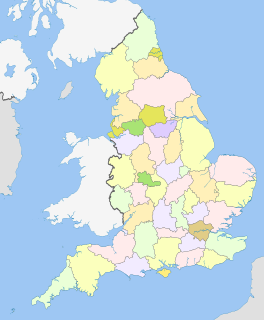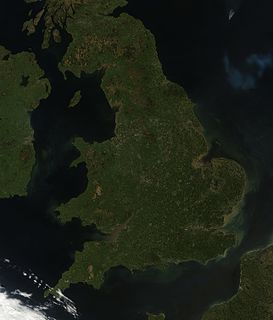| Vice Admiral of the Coast | |
|---|---|
| Active | 1536-19th C. |
| Country | |
| Branch | |
| Type | Naval administration |
| Role | Admiralty courts, Naval Jurisdiction. |
The Vice-Admiralties of the Coast [1] were posts established in each of the twenty maritime counties of England, the North and South of Wales, and the four provinces of Ireland. The officer holders, designated as "vice-admirals", were responsible for naval administration in their county, and were deputies of Lord High Admiral.

An official is someone who holds an office in an organization or government and participates in the exercise of authority.

England is a country that is part of the United Kingdom. It shares land borders with Wales to the west and Scotland to the north. The Irish Sea lies west of England and the Celtic Sea to the southwest. England is separated from continental Europe by the North Sea to the east and the English Channel to the south. The country covers five-eighths of the island of Great Britain, which lies in the North Atlantic, and includes over 100 smaller islands, such as the Isles of Scilly and the Isle of Wight.

Wales is a country that is part of the United Kingdom and the island of Great Britain. It is bordered by England to the east, the Irish Sea to the north and west, and the Bristol Channel to the south. It had a population in 2011 of 3,063,456 and has a total area of 20,779 km2 (8,023 sq mi). Wales has over 1,680 miles (2,700 km) of coastline and is largely mountainous, with its higher peaks in the north and central areas, including Snowdon, its highest summit. The country lies within the north temperate zone and has a changeable, maritime climate.
Contents
A Vice-Admiral's responsibilities included, deciding the lawfulness of prizes captured by privateers, dealing with salvage claims for wrecks, acting as a judge and implementing the role of the impress service. The earliest record of an appointment was of William Gonson as Vice-Admiral of Norfolk and Suffolk in 1536.

A prize court is a court authorized to consider whether prizes have been lawfully captured, typically whether a ship has been lawfully captured or seized in time of war or under the terms of the seizing ship's letters of marque and reprisal. A prize court may order the sale or destruction of the seized ship, and the distribution of any proceeds to the captain and crew of the seizing ship. A prize court may also order the return of a seized ship to its owners if the seizure was unlawful, such as if seized from a country which had proclaimed its neutrality.

A privateer is a private person or ship that engages in maritime warfare under a commission of war. The commission, also known as a letter of marque, empowers the person to carry on all forms of hostility permissible at sea by the usages of war, including attacking foreign vessels during wartime and taking them as prizes. Historically, captured ships were subject to condemnation and sale under prize law, with the proceeds divided between the privateer sponsors, shipowners, captains and crew. A percentage share usually went to the issuer of the commission. Since robbery under arms was once common to seaborne trade, all merchant ships were already armed. During war, naval resources were auxiliary to operations on land so privateering was a way of subsidizing state power by mobilizing armed ships and sailors.

A judge is a person who presides over court proceedings, either alone or as a part of a panel of judges. The powers, functions, method of appointment, discipline, and training of judges vary widely across different jurisdictions. The judge is supposed to conduct the trial impartially and, typically, in an open court. The judge hears all the witnesses and any other evidence presented by the barristers of the case, assesses the credibility and arguments of the parties, and then issues a ruling on the matter at hand based on his or her interpretation of the law and his or her own personal judgment. In some jurisdictions, the judge's powers may be shared with a jury. In inquisitorial systems of criminal investigation, a judge might also be an examining magistrate.
From around 1560 Vice-Admirals of the Coasts acquired a more public profile than they had enjoyed previously. In the second half of the sixteenth century they increasingly received orders from the privy council. In 1561, apparently for the first time, the crown addressed instructions directly to the Vice-Admirals In 1660 their function came under the remit of the Board of Admiralty.
A privy council is a body that advises the head of state of a nation, typically, but not always, in the context of a monarchic government. The word "privy" means "private" or "secret"; thus, a privy council was originally a committee of the monarch's closest advisors to give confidential advice on state affairs.

The Board of Admiralty was established in 1628 when Charles I put the office of Lord High Admiral into commission. As that position was not always occupied, the purpose was to enable management of the day-to-day operational requirements of the Royal Navy; at that point administrative control of the navy was still the responsibility of the Navy Board, established in 1546. This system remained in place until 1832, when the Board of Admiralty became the sole authority charged with both administrative and operational control of the navy when the Navy Board was abolished. The term Admiralty has become synonymous with the command and control of the Royal Navy, partly personified in the Board of Admiralty and in the Admiralty buildings in London from where operations were in large part directed. It existed until 1964 when the office of First Lord of the Admiralty was finally abolished and the functions of the Lords Commissioners were transferred to the new Admiralty Board and the tri-service Defence Council of the United Kingdom.
There are also a few examples of the title Vice-Admiral of the West. It is not however clear whether this was a separate appointment or possibly some incorrect use of an older title being applied to the holders of the Cornwall or Devon post.
The historical title Vice-Admiral of the West is sometimes applied to holders of the crown appointment Vice-Admiral of the Coast of counties in the South West of England.
The holder of the post Vice-Admiral of Devon was responsible for the defence of the county of Devon, England.







